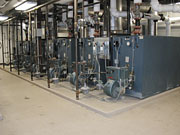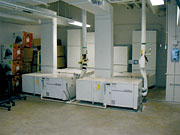
Achieving the "perfect" school ventilation system, however, is often easier said than done. Most school systems have only limited resources available for facilities construction or upgrades. Getting the most out of these funds usually requires trade-offs such as not including air conditioning in northern climates, or selecting the same type of equipment used in existing buildings to save on maintenance costs.
For the past 50 years, unit ventilators have balanced these and other considerations. Readily available and relatively simple in both design and operation, unit ventilators have been widely used since the post-World War II school construction boom, and for good reason. They provide a low-cost means of introducing cooler air to classroom spaces without having to install extensive air conditioning equipment. In winter months, unit ventilators compensate for the "cold wall" effect in rooms with large or multiple windows.
While these and other advantages continue to make unit ventilators an attractive option for schools and other types of buildings, advances in other areas of construction have called increased attention to their drawbacks. For example, their susceptibility to wintertime freeze-ups and poor moisture control during warmer periods can lead to an endless stream of maintenance headaches. The vastly improved thermal efficiency of institutional windows has virtually eliminated the "cold wall" effect, making compensation less of an issue. Similarly, insulation in interior and exterior walls can now achieve a net gain in ambient heat retention, making classroom cooling a year-round requirement.
The expanding body of indoor air quality (IAQ) research has led to other concerns about the application of unit ventilators. Even a three-degree temperature differential from one side of a room to another can be both uncomfortable and unhealthy, as is the problem of distributing a constant flow 55 degrees F air at the students' head level. Many types of unit ventilators do not accommodate high-efficiency filters, and fall short in meeting more stringent requirements for outside air intake.
Then there's the issue of space. Individually, a unit ventilator may not appear very large. Collectively, however, they take up valuable space that could be used for other purposes in classrooms, labs, auditoriums, offices, and other schoolrooms.
The Fan-powered VAV Option
In existing school buildings, particularly those with limited ceiling space, upgrading and optimizing the existing unit ventilator systems may be the only way to improve the classroom environment. For school systems undertaking new construction projects, there are a variety of alternatives, the most popular of which are fan-powered variable-air volume (vav) systems.A fan-powered vav ventilation system uses minimal energy to combine constant airflow and plenum heat to maintain a constant room temperature. Individual room control is achieved through a constant-volume, variable-temperature flow of air from the terminal unit mounted above the ceiling.
Each fan-powered terminal contains a hot water reheat coil, and is linked to the air-handling unit (AHU) with medium-pressure ductwork. Sophisticated controls in each space constantly monitor temperature, humidity, and airflow, making adjustments as needed to maintain the desired conditions. Fresh air for the vav system is brought in from a single elevated source, and regulated automatically based on the specific space occupancy and cooling requirements. The result is consistent air exchange (6 to 8 air changes per hour) and temperature control, all with an extremely low noise level that is well within recommended limits for indoor environments, including classrooms.
A typical school configuration combines centralized AHUs and fan-powered terminals to condition individually controlled areas such as classrooms, cafeterias, media centers, science labs, art rooms, and corridors. Auditoriums, locker rooms, gymnasiums, and other large spaces may utilize packaged, single-zone, constant-volume AHUs. The overhead location of vav components promotes flexibility in space layouts, and offers more opportunities to subdivide multi-use spaces with movable walls and partitions. Likewise, the configuration eliminates the need for roof-mounted mechanical equipment, improving the aesthetics of the school's exterior.
Perhaps the most attractive feature of vav systems is the flexibility to adjust to shifting cooling loads over the course of the school day, and during low-use periods such as nights and weekends. Instead of designing the ventilation system for maximum capacity, the vav's total system cooling load may be calculated based on space and block load requirements.
System operation (and, accordingly, energy consumption) varies depending on the amount of cooling necessary for a particular location. Vav units serving idle classrooms, for example, would provide only minimal ventilation until the monitoring units sense that teachers and students have returned. If an after-school event or meeting is scheduled for the auditorium, those vav units can provide the needed cooling while those serving the empty classroom areas cut back on service until school resumes in the morning.
This approach can reduce the cooling equipment requirements by as much as 30%, and allow for greater diversity in other equipment such as pumps. Therefore, equipment for a typical 90,000-sq-ft elementary school could be sized to handle a cooling load of 130 tons, rather than the 200 tons necessary under a conventional cooling system.

Balancing The Equation
No ventilation system is ideal for every application, and vav systems have their share of drawbacks. Most require at least 2 ft of overhead space for the ductwork and terminals, requiring the project architect and building systems engineer to closely coordinate the school's functional and aesthetic features with the ventilation system requirements. Low ceilings in older school buildings may also preclude a retrofit using vav technology.The complexity of vav systems also requires a longer, more extensive commissioning effort to achieve an optimal balance of the various components. In larger schools, tight construction schedules may require this commissioning process to overlap with the start of classes, resulting in understandable frustration among teachers, administrators, and students when workers are continually "working the bugs out" of their new school.
Equipment for vav systems is also more expensive than other ventilation alternatives. However, cost savings from the system's energy-efficiency and load-balancing capabilities usually result in a relatively short payback time, allowing the school district to enjoy a net gain in long-term energy savings.
Many technology innovations have emerged to offset these drawbacks. Highly accurate airflow measuring stations on the AHUs automatically fine-tune the outside airflow, and compensate as needed for increased carbon dioxide levels. Vav hardware and software have improved as well, increasing both the versatility and reliability of individual components and the overall system.
One area that has benefited most from these advancements is maintenance. Though somewhat more sophisticated than other types of ventilation systems, vav equipment is nevertheless relatively simple on which to work. The use of standardized components in most systems also enhances the ease of long-term maintenance. Most configurations call for the bulk of vav components to be located above corridors; when maintenance is necessary, the work can proceed without disturbing classroom activities.

VAV In Action
Chesterton (IN) High School, one of the largest and most ambitious high school construction projects completed in the United States within the past few years, illustrates the advantages of fan-powered vav ventilation systems. Dedicated in the fall of 2000, the 530,000-sq-ft building contains a variety of expansive spaces to accommodate nearly 2,000 students in grades 9 through 12, as well as community activities. The school contains a 14,245-sq-ft media center a 1,031-seat auditorium, a large field house with gymnasium and natatorium, over 100 computer-ready classrooms and laboratories, art studios, shop areas, and a fully equipped radio and television production studio. There's even a 1,800-sq-ft group instruction/practice area for Chesterton High School's award-winning speech and debate program.Given the diverse range of activities under one roof and the shifting cooling loads, Chesterton was an ideal candidate for a fan-powered vav ventilation system. Fanning/Howey Associates, Inc. (Michigan City, IN) incorporated a mezzanine level within the school's two-story academic area to provide space for the 236 vav boxes serving the complex. The central air intake/exhaust system includes 54 AHUs, 5 large return fans, and 237 exhaust fans. The system's total fan air moving capacity exceeds 1.066 million cfm, and provides 1,200 tons of cooling power.
Chesterton's heating and cooling is provided by a series of modular boilers, and a central air cooled chiller linked to modular compressors. Because the vav system constantly adjusts its operations to load shifts throughout the building, the compressors and boilers stage on and off as needed.
As a result, these systems are always firing at the most efficient energy level. In fact, during the school's first winter of operation, most days required the use of only a single boiler, the main purpose of which was to preheat outside air. Such efficient operation is a credit to the vav system's ability to make the best use of latent heat in the ventilation system.
During construction, the only difficulties experienced with Chesterton High School's fan-powered vav ventilation system came during the commissioning process, when improper static settings for the main AHUs caused the system to operate with more noise than expected. Balancing the static levels quickly resolved the problem, readying the system for full operation. Midway through the high school's second full year of operation, the school's energy consumption levels have met design targets.
In Search Of More Savings
For new schools located in cold-weather climates, the operational and load-shifting characteristics of fan-powered vav systems lend themselves to other energy saving options. One approach is a closed loop of geothermal heat pumps. Coupling individual room-sized heat pumps through a piping loop, the earth's natural heating properties keeps a constant flow of 55 degrees to 60 degrees water circulating through the building. The heat pumps in each space draw as much heat from this loop as needed to condition fresh air drawn from central intake units and to condition the space.Although closed geothermal heat pumps have been used sparingly around the country, the systems offer numerous advantages. They are very energy efficient, producing 5 W of heat for every watt used. Combined with fan-powered vav ventilation, the individual heat pumps allow for greater control over classroom environments.
But while the initial cost of geothermal heat pumps is lower than for many other types of systems, the units have a shorter life span. The system requires many compressors and a connected cooling load to help balance the temperature. The heat pump design limitations also raise problems with controlling airflow and temperature in auxiliary spaces.
Perhaps the biggest drawback is the relatively high utility cost associated with geothermal systems. While the systems enjoy a relatively high coefficient of performance, the energy required to power the all-electric system can be expensive. Local and regional codes may also preclude the use of these systems, as would a school's proximity to wetlands. For the most part, applications of geothermal energy are limited to those school systems able to negotiate lower utility rates from their service providers.
Maywood Elementary School in Hammond, IN is one location where geothermal energy has combined with heat pumps to provide a cost-effective energy management system. Designed by Fanning/Howey Associates, the 92,000-sq-ft elementary school is configured in pods, each of which houses 10 classrooms along with two commons areas, four small group instruction rooms, restroom facilities, and coatroom space. Folding partitions at various locations help maximize the flexibility of space usage.
Maywood's fresh air is supplied from an AHU located on the mezzanine above the restrooms, serving individually controlled heat pumps in each pod. In addition, the geothermal heat pump system consists of 240 vertical wells drilled to a depth of 135 ft located in front of the school. A total of 78 horizontal heat pumps are located in the school's ceilings linked to the energy control system. The heat pumps and mechanical equipment are located in the ceiling, which allows full use of classroom space. As with Chesterton High School, the ceiling and mezzanine storage of the heat pumps and other mechanical equipment eliminated the need for roof-mounted equipment and improved the aesthetics.
Maywood's energy management system is linked to the building-wide computer network to monitor and control all building hvac functions. The computer network also links to the low-voltage lighting system, which is interfaced with ultrasonic motion detectors to control lighting in classrooms and toilets, as well as to signal the security system in the event of an intruder in the building.
The energy management station is equipped with a weather station that records outside temperature, wind speed, and direction. The reading will activate the heat system first on the side of the building that experiences the coldest outside temperature and windblasts. Once this side of the building has reached the desired comfort level, the remainder of the building heat system is sequenced into action. This action provides energy savings by bringing the coldest section of the building to a desired comfort level before activating the system throughout the school.

Designing For Safety
Until recently, cost, energy efficiency, and ease of maintenance were the main criteria for selecting a classroom ventilation system. Recent events in the United States have led many school administrators to take a closer look at the security and safety of their building systems. While deliberate acts against schools are generally considered unlikely, administrators naturally prefer to err on the side of caution when it comes to protecting the health and safety of their students and staff.The inherent features of fan-powered vav systems and geothermal energy systems provide the level of security that most schools want. Both systems have digital controls, allowing the systems to be shut down quickly if necessary. Unlike ground-level unit ventilators, the centralized air intake units for vav systems and heat pumps are located well out of reach, greatly reducing the potential for tampering as well as the inadvertent intake of exhaust fumes from busses and other vehicles.
Heightened awareness about potential threats to school ventilation systems has also reminded school administrators and engineers alike of the need to account for other potentially harmful substances that are part of everyday life in our nation's schools. The presence in ventilation systems of chemicals from art rooms and science labs, cleaning compounds, paints, and other materials can easily cause widespread discomfort and even illness. As such, architects and engineers should pay special attention to providing proper storage spaces for these materials, and set proper pressure differentials to minimize opportunities for airborne pollutants to spread to other parts of the building.
School hvac systems will no doubt remain an important focal point for administrators and engineers in the years ahead. Research is expanding our knowledge of IAQ issues, while technology provides more tools to fine-tune the performance of school building systems. But because resources for school facilities will likely remain limited in most parts of the country, balancing these considerations to maximize the system's overall value will continue to be a high priority. Technologies such as fan-powered vav and geothermal energy offer a sound foundation for schools to meet this challenging but achievable goal. ES
